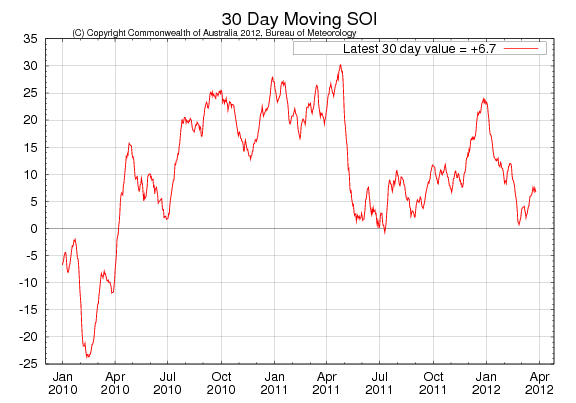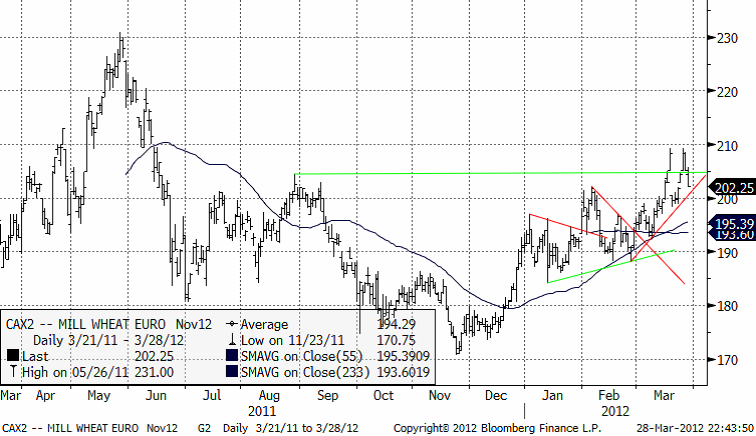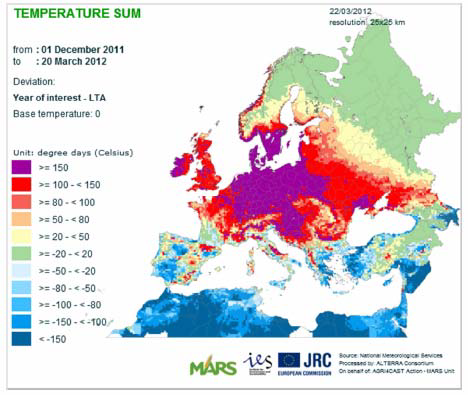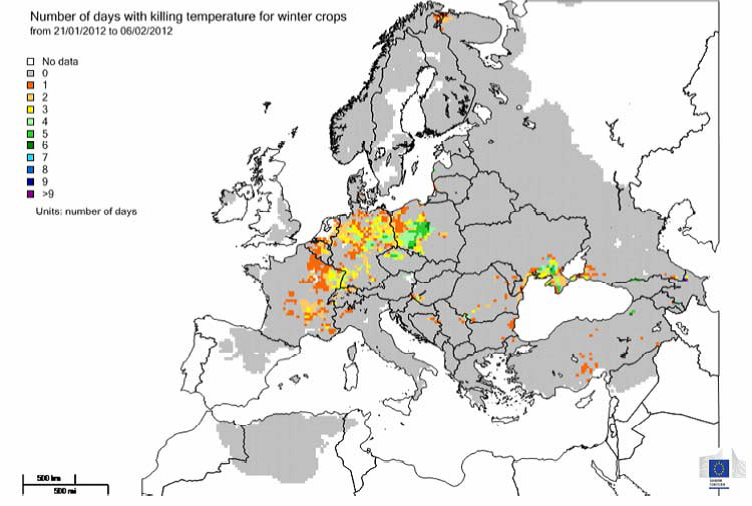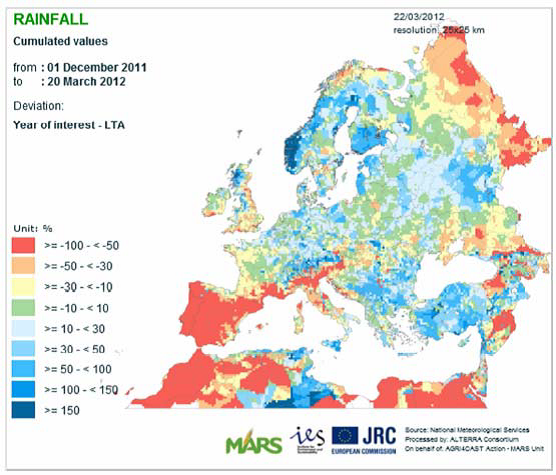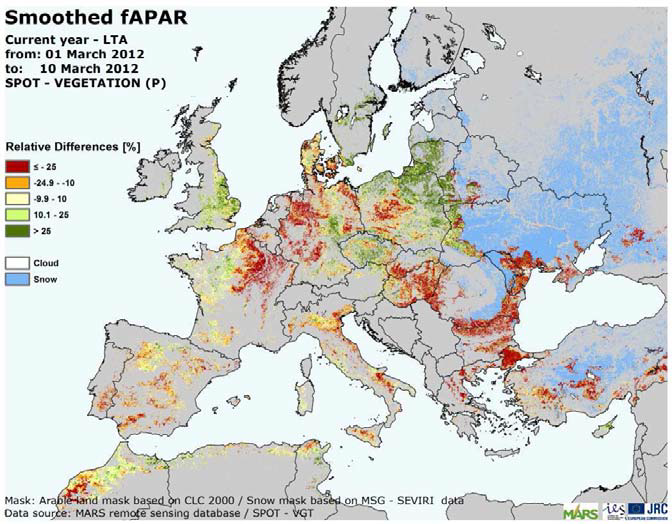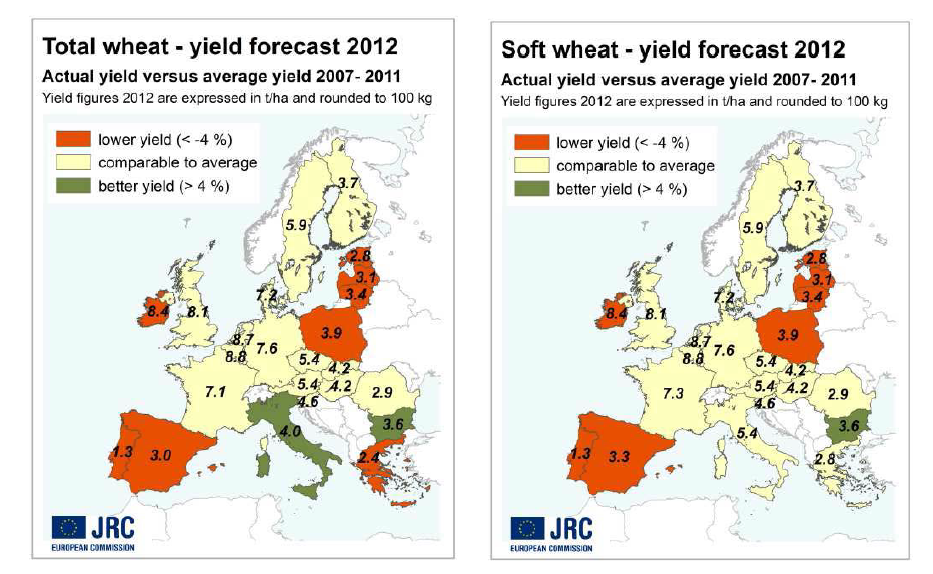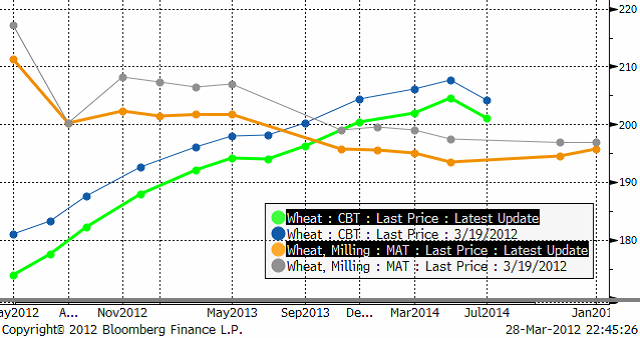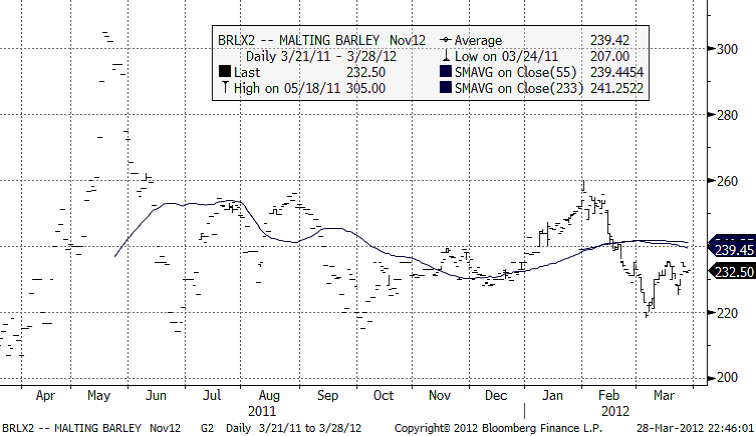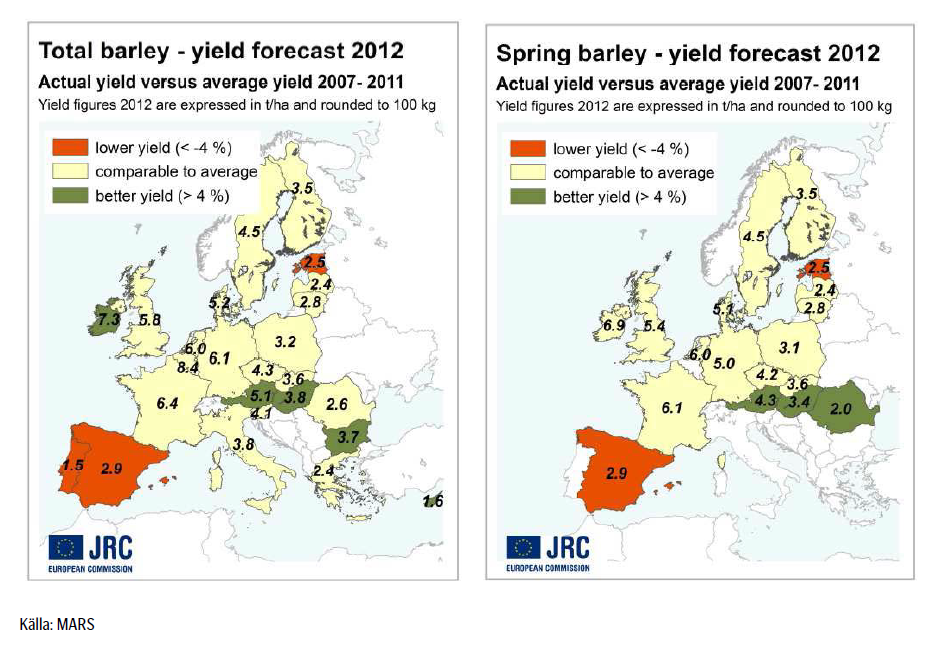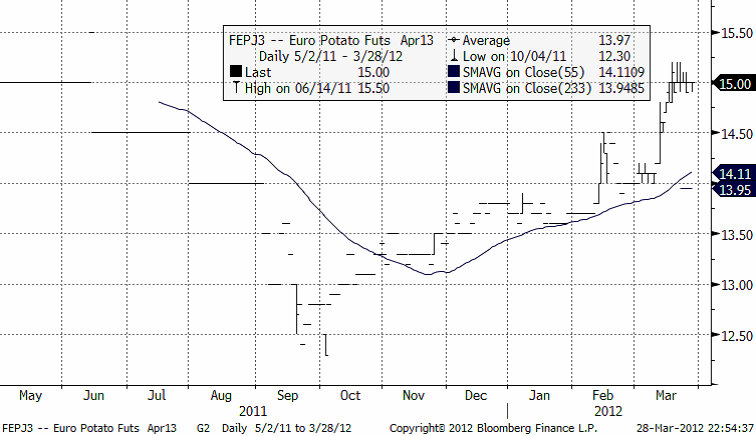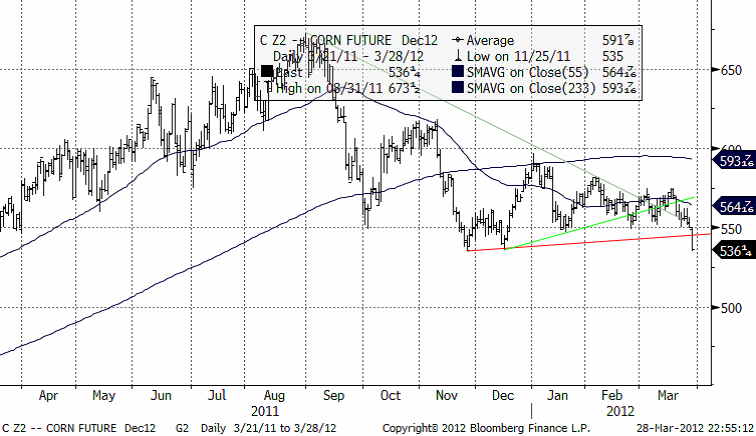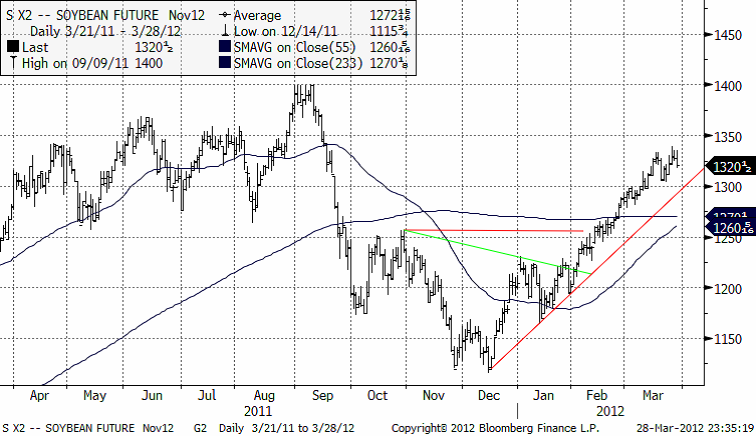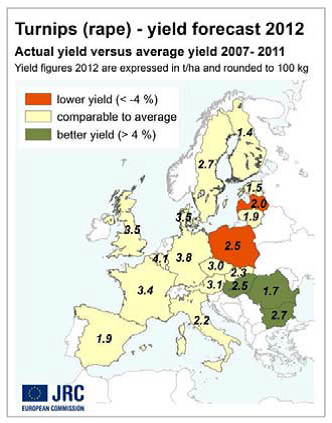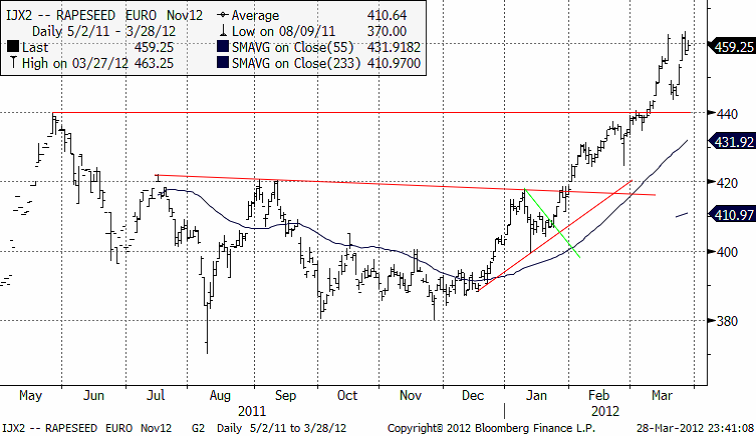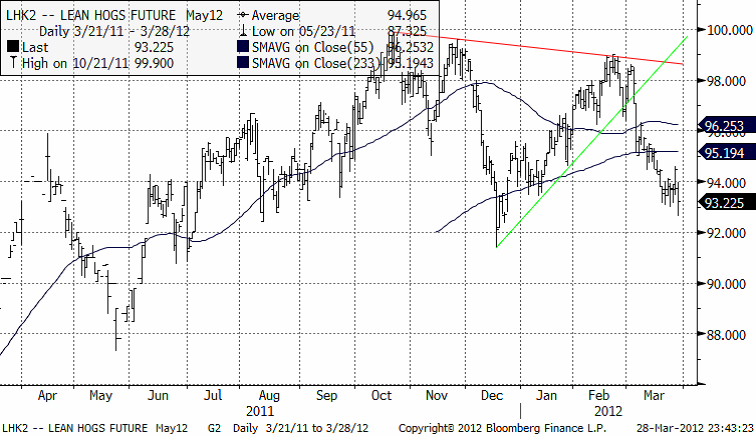Analys
SEB – Jordbruksprodukter, vecka 13 2012
 Majspriset har sjunkit ett par procent men för andra jordbruksprodukter har prisförändringarna den senaste veckan varit en procent som på sin höjd. Sent under onsdagen (igår) föll majspriset genom stödet på 550 cent under starkt säljtryck. Övertygelsen i rörelsen är stark och man bör akta sig för att lockas att ”fyndköpa” spannmål anser vi. Det kan mycket väl bli ett prisfall på spannmål överlag i dagarna som kommer.
Majspriset har sjunkit ett par procent men för andra jordbruksprodukter har prisförändringarna den senaste veckan varit en procent som på sin höjd. Sent under onsdagen (igår) föll majspriset genom stödet på 550 cent under starkt säljtryck. Övertygelsen i rörelsen är stark och man bör akta sig för att lockas att ”fyndköpa” spannmål anser vi. Det kan mycket väl bli ett prisfall på spannmål överlag i dagarna som kommer.
Anledningen till prisfallet är tidiga rapporter om att höstvetet i USA på många håll är i ”enormt mycket bättre skick än förra året”. 75% av Oklahomas och 59% av Kansas vete är i ”good” eller ”excellent” condition.
Imorgon (fredag) kommer USDA:s prospective planting / quarterly stocks. Det blir en spännande dag för majs och sojabönor i synnerhet. Prognosintervallen är ovanligt stora, vilket tyder på stor osäkerhet i marknaden.
Odlingsväder
Southern Oscillation Index, som mäter ENSO och indikerar La Niña om SOI > +8 och El Niño om SOI < -8, har stigit 0,8 enheter till +7.1 i den senaste rapporten från Australiens meteorologiska byrå.
Vete
Novemberterminen på Matif misslyckades med att nå över 210 euro per ton. Den stödlinje som följt uppgången och nu ligger strax under priset, kan brytas under torsdagens eller fredagens handel om prisfallet fortsätter i USA. Crop condition uppskattas i USA att komma in på en högre nivå än novembers sista mätning på 52%. Från Oklahoma rapporteras t ex fenomenalt goda 75% i good / excellent condition. 9 april kommer vårens första crop condition från USDA.
Argentinas veteproduktion för 2012/13 beräknas uppgå till 12 mt. Sådd areal beräknas minska till 4 miljoner hektar, vilket är i nivå med 2009/2010 och den lägsta sedan 1977/78. Enligt USDA är det flera analytiker som räknar med en ännu större nedgång, men många producenter har inga andra alternativ och andra behöver så vete för att med pengar därifrån finansiera produktionen av sojabönor och majs. Regeringen förväntas fortsätta styra den lokala vetemarknaden och reserverar ca 7 mt för det inhemska behovet med möjlig export av överskottet. Producenterna hävdar att detta system gör det svårt att kommersialisera grödan (många har fortfarande vete kvar från tidigare säsonger) och priserna blir också lidande pga bristen på konkurrens mellan lokala kvarnar och exportörer. Det största bortfallet av areal förväntas bli i det rika majsbältet, där producenter troligen föredrar att så sojabönor som första gröda och sedan vete, istället för en dubbel skörd med vete. I centrala och södra Buenos Aires-provinsen förväntas arealen minska marginellt eftersom det där finns färre produktionsalternativ.
Den Europeiska kommissionens analysenhet MARS kom med sin rapport i början på veckan och sammanfattar där att det generellt rådde mildare väder än normalt från början av december fram till de sista dagarna i januari för större delen av Europa. Den högre än normala temperaturen för säsongen under första halvan av vintern gynnade groning och rotskottsstadiet för höstgrödor, men försenade eller hindrade vinterhärdningsprocessen vilket gjorde att dessa grödor utsattes för en högre risk för utvintring.
I västra Europa var grödorna inte alls förberedda och toleranta mot frysgrader och i vissa centrala delar av Europa samt i västra Polen och runt Svarta havet var grödorna endast någorlunda vinterhärdiga. Som en följd av det varma vädret, så var snötäcket obefintligt eller alldeles för tunt i Västeuropa och Polen och även runt Svarta havet samt i ytterligare några regioner i Ukraina när köldknäppen slog till i slutet på januari och temperaturerna sjönk drastiskt, framförallt i centrala och östra Europa. Det tunna snötäcket i t.ex Polen, Tjeckien och runt Svarta havet var inte tillräckligt för att skydda grödorna effektivt under de första dagarna då kylan slog till.
Temperaturen nådde ner till -20 grader i stora områden mellan östra Tyskland och Bulgarien, och längs Polens östra gräns, Slovakien och Rumänien sjönk temperaturen till och med under -25 grader. I början på februari förbättrades dock situationen då snöfall drog in över Ungern, Rumänien, Bulgarien och Balkanhalvön. Några mindre snöfall underlättade också situationen i västra Europa.
Sedan förra månadens rapport har dock ingen ytterligare relevant utvintring konstaterats. Den köldperiod som har orsakat störst skador inträffade under de sista dagarna i januari och i den första halvan av februari. MARS modellsimuleringar indikerar sannolik utvintring i östra Frankrike, Beneluxländerna, Tyskland, Polen, Tjeckien, vissa delar av Rumänien och även i Ukraina (främst runt Krim halvön). Antalet dagar med kritiska temperaturer uppgick till mellan 4 och 9 i dessa områden där betydande bortfall är sannolikt och som nu också bekräftats i bred utsträckning till följd av en ogynnsam utveckling av grödorna som har observerats.
Den låga temperaturen i februari har också lett till en fördröjd fenologisk utveckling i Medelhavsregionen. De milda temperaturer som nu råder i västra och östra Europa är dock gynnsamma för vårbruk och ger lantbrukare möjlighet att besluta om skadade höstgrödor istället ska ersättas med vårgrödor.
Delar av Europa har upplevt bristfällig eller helt utebliven nederbörd, även om den ackumulerade nederbörden översteg genomsnittet i Norge, Finland, Vitryssland, västra Ryssland, Georgien, Grekland, Turkiet, södra Italien och Tunisien i första halvan av mars. Allvarlig brist på regn har sedan december observerats i Spanien, Portugal och Marocko. Vinternederbörden som har registrerats för södra Frankrike, norra Italien och vissa områden i England, Österrike, Slovenien och Ungern samt i södra och östra delarna av europeiska Ryssland ligger under genomsnittet.
Framförallt Spanien och Portugal står inför svåra problem med vattenförsörjningen. Nederbörden över den iberiska halvön uppmättes till 10 mm i mars och torkan fortsätter. Det ackumulerade genomsnittliga underskottet av nederbörd för länderna sedan den 1 oktober visar på 300 mm för Portugal och 155 mm för Spanien och närmar sig därmed de mest extrema åren. Analysen av de mest likartade åren tyder på att denna situation är exceptionell. Vattenunderskottet drabbar merparten av Portugal och regionerna Andalusien, Extremadura och Castilla Y León i Spanien. De milda vintertemperaturerna mildrade dock den aktuella situationen för grödorna något men den låga nivån av vattenreservoarer och tunt snötäcke i bergen förväntas leda till brist på bevattnings möjligheter framöver.
Även om det finns synliga tecken på vattenbrist i södra Frankrike, centrala och norra delen av Italien samt vissa områden i England, Österrike, Slovenien och Ungern, verkar denna situation mindre allvarlig jämfört med den iberiska, men nederbörd är nu mycket önskvärd för dessa regioner.
Eftersom det fortfarande är tidigt på säsongen så baseras MARS prognoser på trender och medelvärden förutom prognoserna för durumvete i Spanien, Portugal och Italien där grödorna är nära blomning. Till följd av torkan i de viktigaste durumveteproducerande regionerna i Spanien, så ligger prognoserna klart under genomsnittet eftersom det inte är möjligt att uppnå full avkastningspotential även om den återstående växtsäsongen blir god.
I bilden nedan visar den röda tonen de synliga jordbruksområdena med en dålig alt försenad start på säsongen, det motsatta gäller för de gröna områdena. På den iberiska halvön syns en ökad negativ säsong med en trend norr – söder. I de norra jordbruksområdena är växtperioden i ett mycket tidigt skede och lider därför inte av den torra vinterperioden medan grödorna i de södra områdena lider av långvarig brist på regn. Situationen har försämrats sedan början av februari och drabbar durumvetets utveckling framförallt i Portugal.
Södra Italien har haft kallare och blötare väderförhållanden än vanligt och utvecklingen av durumvete och starten på säsongen för andra höstgrödor har försenats. Storbritannien och västra Frankrike har gynnats av de milda vintertemperaturerna med en bra start på säsongen för höstgrödorna. I östra Frankrike och västra Tyskland avtog grödornas utveckling efter köldknäppen i februari och orsakade, framförallt i Frankrike, utvintring.
De viktigaste durumveteproducerande regionerna i Tyskland visar dock på en återväxt trots temperaturerna i februari. Olika förhållanden råder bland regionerna på gränsen mellan Tyskland och Polen där vintergrödorna visade en positiv utveckling innan vintervilan, men som nu uppvisar en fördröjning i utvecklingen. I Östeuropa fick grödorna en dålig start på säsongen på grund av den torra hösten och därefter den kraftiga vinterkylan. I Grekland är durumvetets och höstgrödornas utveckling starkt försenad på grund av de ovanligt låga temperaturerna i januari och februari. I Turkiet, Ukraina och Ryssland finns fortfarande ett ihållande snötäcke.
MARS estimerar EU27´s avkastning för den totala veteproduktionen för 2012 till 5.41 t/ha, en liten uppgång jämfört med förra året (5.36 t/ha). Avkastningen för ”mjukt” vete estimeras till 5.67 t/ ha (tidigare 5.58 t/ha) och durumvete estimeras till 3.16 t/ha (tidigare 3.41 t/ha).
Trots i stort sett idealiska förhållanden för sådd av 2012/13 års grödor i Australien, så förväntas arealen för vete och korn att minska jämfört med förra året då lantbrukare istället väljer att producera canola utifrån mer lönsamma priser.
Den totala arealen för sådd av vete för 2012/13 (säsongen börjar oktober 2012) beräknas uppgå till 13.5 miljoner hektar, vilket skulle vara en betydande minskning jämfört med föregående års rekord areal på 14.1 miljoner hektar, men fortfarande i linje med det tio-åriga genomsnittet på 13.21 miljoner hektar (enligt historisk data från ABARES).
Rekordsådden av vete under 2011/12, vilket följde en nästan lika hög sådd året innan, sätter press på vissa lantbrukares växtföljd och därmed gå från veteproduktion till grödor som raps och baljväxter. En kraftig nedgång i de inhemska vetepriserna, jämfört med de mer lönsamma priserna på canola, förväntas också bidra till ökad areal för canola på bekostnad av vete och korn.
Sådden börjar vanligtvis i mitten till slutet av april och fortsätter fram till juni, men de kraftiga regn (och översvämningar) som östra Australien har fått tagit del av kommer sannolikt att möjliggöra en tidigare start där.
Australiens veteproduktion för 2012/13 beräknas uppgå till 27 mt enligt USDA (vilket är något högre än ABARES estimat på 26 mt i början på månaden), en nedgång med ca 6.5% jämfört med rekordproduktionen på 28.9 mt under 2011/12 men fortfarande över genomsnittet.
Estimatet för landets totala veteexport för 2012/13 ligger på 19.5 mt, vilket är en minskning från den reviderade uppskattningen på 20.5 mt från föregående år som anses vara ett historiskt rekord. Nedgång i produktionen och sämre utsikter, delvis driven av en stark australiensisk dollar, förväntas bidra till den minskade exporten.
Nedan ser vi terminskurvorna för Chicagovete och Matif-vete. Notera att marknaden på Matif är kraftigt utökad i löptid, vilket gör det möjligt att tillämpa den effektiva ”trappstegsmetoden” för att prissäkra variation i priser över flera år.
Vi ser prisfall för alla löptider på Chicagobörsen och även samma sak på Matif (augusti 2012 ska man inte titta på, den är för illikvid).
Vi fortsätter att ha en negativ vy på i synnerhet Matifs terminspriser och då särskilt de med kort löptid, de med leverans det närmaste året.
Maltkorn
Novemberkontraktet på maltkorn ligger fortfarande under glidande medelvärden och det brukar tolkas negativt.
Argentinas kornproduktion för 2012/13 förväntas uppgå till 5.4 mt. Producenter ser korn som ett väldigt bra alternativ till vete eftersom regeringen inte lägger sig i handeln med korn. Sådd areal förväntas uppgå till 1.5 miljoner hektar, en ökning med 50 procent, och den högsta nivån de senaste 50 åren. Producenter har haft 2 år på raken med goda kornskördar, höga priser och utan restriktioner i försäljningen. Med förväntade priser och genomsnittlig avkastning, förväntas därför intäkterna att bli högre än för vete. Olika faktorer, bland annat en stark global efterfrågan, en ny marknad i Kina och flertalet stora handelshus som är verksamma på marknaden uppmuntrar lantbrukare att öka arealen.
Korn ger dessutom lantbrukarna en stor fördel eftersom de kan så en andra skörd (vanligtvis sojabönor) två veckor tidigare än om den första grödan är vete. De områden där produktionen förväntas öka är i huvudsak i södra Santa Fe och norr om Buenos Aires. Det råder dock vissa tvivel om att det finns tillräckligt med frön för en sådan stor expansion, men det sägs att lantbrukarna behållit tillräcklig med frön från tidigare säsong.
I Australien förväntas arealen för korn att uppgå till 3.8 miljoner hektar för 2012/13 vilket är en minskning från den estimerade nivån för förra året. Låga priser på foderspannmål och ökad konkurrens från canola ses som bidragande orsaker. Prognosen skulle också anses vara under genomsnittet enligt historisk data från ABARES.
En förväntad avkastning på 2.1 t/ha för 2012/13 är dock den högsta prognostiserade avkastningen på över ett decennium. Produktionen förväntas uppgå till 8.0 mt vilket är en nedgång från estimatet på 8.5 mt för föregående år och med en export prognos på 3.75 mt vilket är något under det reviderade estimatet på 4.0 mt för 2011/12.
Lägre produktion och en historiskt hög Australiensisk dollar är faktorer som påverkar. MARS estimerar EU27´s avkastning för den totala korn produktionen för 2012 till 4.41 t/ha, en liten uppgång jämfört med förra året (4.30 t/ha). Avkastningen för vårkorn estimeras till 3.88 t/ ha (tidigare 3.81 t/ha) och höstkorn estimeras till 5.24 t/ha (tidigare 5.06 t/ha).
Potatis
Priset på industripotatis för leverans nästa år tog en paus efter förrförra veckans kraftiga prisuppgång. Priset har 15 euro som fixpunkt för den aktuella handeln.
Majs
Majspriset föll igår kväll genom stödet på 550 cent / bushel. Säljsignalen går inte att missa. Priset bör rimligen kunna gå ner till 500 cent nu på kort tid. På fredag publicerar USDA statistik på lager och förväntad areal i år. En survey gjord av AgView där lantbrukare tillfrågats om sina lager, inplicerar lager på 1.8 mbu (mot 3.8 mbu förra året). Denna information kom tidigare i veckan. Marknaden har alltså svalt detta och ändå gått ner.
Marknadens nyfunna momentum – nedåt – indikerar ett starkt och övertygat säljtryck. Detta är antagligen det ”utbrott” från konsolideringsfasen som marknaden väntat på.
Sojabönor
Efter förra veckans veckobrev gick sojabönspriset först upp, men började veckan med att stå till och föll så under onsdagen, tillsammans med andra jordbruksprodukter. Sojamjölet står dock fortfarande på plus sedan förra veckan.
Raps
MARS estimerar EU27´s avkastning i rapsproduktionen för 2012 till 3.02 t/ha, en uppgång jämfört med förra årets 2.88 t/ha.
Nedan ser vi kursdiagrammet för novemberkontraktet.
440 euro utgör nu, när den nivån är bruten, ett tekniskt stöd. Vi fortsätter därför att ha en neutral vy, om inte 440-nivån bryts igen.
Gris
Majkontraktet står faktiskt på exakt samma pris som det gjorde för en vecka sedan. Däremellan har det däremot rört sig både över och under den nivån. Priset föll under gårdagen (onsdagen) ganska kraftigt men stängde över dagens lägsta notering. Förmodligen är inte fallrisken så stor i dagsläget. Stöd finns redan på 92 cent per pund. På lite längre sikt, i synnerhet om majspriset faller, ”borde” grispriset följa efter.
[box]SEB Veckobrev Jordbruksprodukter är producerat av SEB Merchant Banking och publiceras i samarbete och med tillstånd på Råvarumarknaden.se[/box]
Disclaimer
The information in this document has been compiled by SEB Merchant Banking, a division within Skandinaviska Enskilda Banken AB (publ) (“SEB”).
Opinions contained in this report represent the bank’s present opinion only and are subject to change without notice. All information contained in this report has been compiled in good faith from sources believed to be reliable. However, no representation or warranty, expressed or implied, is made with respect to the completeness or accuracy of its contents and the information is not to be relied upon as authoritative. Anyone considering taking actions based upon the content of this document is urged to base his or her investment decisions upon such investigations as he or she deems necessary. This document is being provided as information only, and no specific actions are being solicited as a result of it; to the extent permitted by law, no liability whatsoever is accepted for any direct or consequential loss arising from use of this document or its contents.
About SEB
SEB is a public company incorporated in Stockholm, Sweden, with limited liability. It is a participant at major Nordic and other European Regulated Markets and Multilateral Trading Facilities (as well as some non-European equivalent markets) for trading in financial instruments, such as markets operated by NASDAQ OMX, NYSE Euronext, London Stock Exchange, Deutsche Börse, Swiss Exchanges, Turquoise and Chi-X. SEB is authorized and regulated by Finansinspektionen in Sweden; it is authorized and subject to limited regulation by the Financial Services Authority for the conduct of designated investment business in the UK, and is subject to the provisions of relevant regulators in all other jurisdictions where SEB conducts operations. SEB Merchant Banking. All rights reserved.
Analys
Brent crude inching higher on optimism that US inflationary pressures are fading


Brent crude price inching higher on optimistic that US inflationary pressures are fading. Brent crude closed up 1.1 USD/b ydy to a close of USD 86.39/b which was the highest close since the end of April. This morning it is trading up another half percent to USD 86.9/b along with comparable gains in industrial metals and Asian equities. At 14:30 CET the US will publish its preferred inflation gauge, the PCE figure. Recent data showed softer US personal spending in Q1. Expectations are now high that the PCE inflation number for May will show fading inflationary pressures in the US economy thus lifting the probability for rate cuts later this year which of course is positive for the economy and markets in general and thus positive for oil demand and oil prices. Hopes are high for sure.
Brent crude is trading at the highest since the end of April
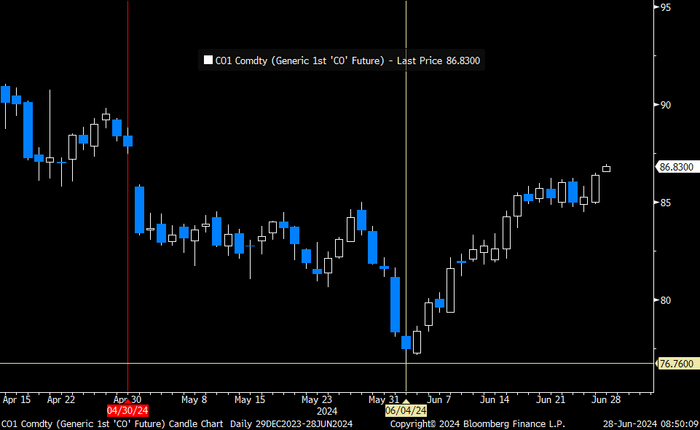
The rally in Brent crude since early June is counter to rising US oil inventories and as such a bit puzzling to the market.
US commercial crude and oil product stocks excluding SPR.
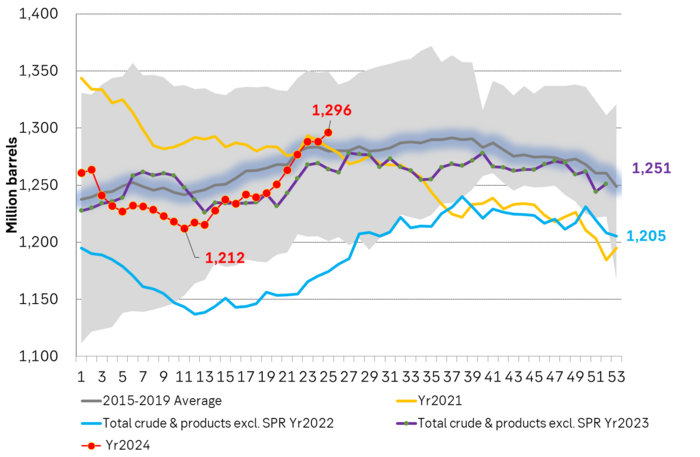
Actual US crude oil production data for April will be published later today. Zero growth in April is likely. Later today the US EIA will publish actual production data for US crude and liquids production for April. Estimates based on US DPR and DUC data indicates that there will indeed be zero growth in US crude oil production MoM in April. This will likely driving home the message that there is no growth in US crude oil production despite a Brent crude oil price of USD 83/b over the past 12 mths. The extension of this is of course rising expectations that there will be no growth in US crude oil production for the coming 12 months either as long as Brent crude hoovers around USD 85/b.
US production breaking a pattern since Jan 2014. No growth at USD 83/b. What stands out when graphing crude oil prices versus growth/decline in US crude oil production is that since January 2014 we have not seen a single month that US crude oil production is steady state or declining when the Brent crude oil price has been averaging USD 70.5/b or higher.
US Senate looking into the possibility that US shale oil producers are now colluding by holding back on investments, thus helping to keep prices leveled around USD 85/b.
Brent crude 12mth rolling average price vs 4mth/4mth change in US crude oil production. Scatter plot of data starting Jan 2014. Large red dot is if there is no change in US crude oil production from March to April. Orange dots are data since Jan 2023. The dot with ”-1.3%” is the March data point.
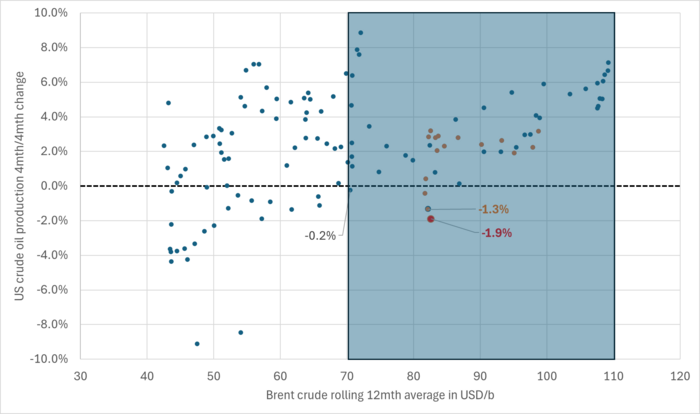
Brent crude 12mth rolling average price vs 4mth/4mth change in US crude oil production. Data starting Jan 2014. The last data point is if there is no change in US crude oil production from March to April.
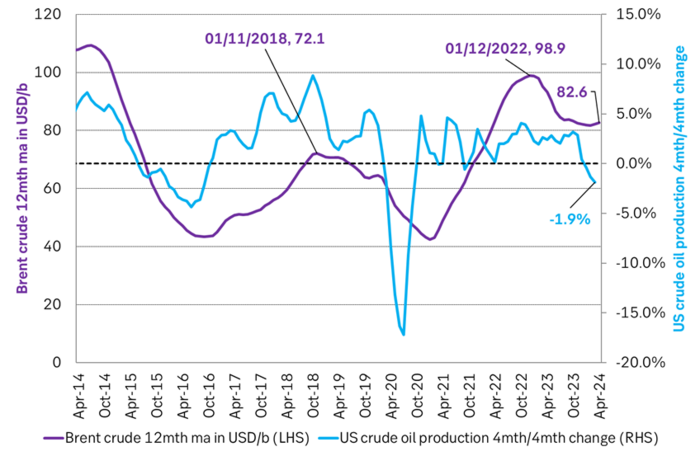
Analys
Price forecast update: Weaker green forces in the EU Parliament implies softer EUA prices


We reduce our forecast for EUA prices to 2030 by 10% to reflect the weakened green political agenda in the EU Parliament following the election for the Parliament on 6-9 June. The upcoming election in France on 7 July is an additional risk to the political stability of EU and thus in part also to the solidity of the blocks green agenda. Environmental targets for 2035 and 2040 are most at risk of being weakened on the margin. EUA prices for the coming years to 2030 relate to post-2030 EUA prices through the bankability mechanism. Lower post-2030 climate ambitions and lower post-2030 EUA prices thus have a bearish impact on EUA prices running up to 2030. Actual softening of post-2030 climate ambitions by the EU Parliament have yet to materialize. But when/if they do, a more specific analysis for the consequences for prices can be carried out.
EUA prices broke with its relationship with nat gas prices following the EU Parliament election. The EUA price has dutifully followed the TTF nat gas price higher since they both bottomed out on 23 Feb this year. The EUA front-month price bottomed out with a closing price of EUR 50.63/ton on 23 Feb. It then reached a recent peak of EUR 74.66/ton on 21 May as nat gas prices spiked. Strong relationship between EUA prices and nat gas prices all the way. Then came the EU Parliament election on 6-9 June. Since then the EUA price and TTF nat gas prices have started to depart. Bullish nat gas prices are no longer a simple predictor for bullish EUA prices.
The front-month EUA price vs the front-year TTF nat gas price. Hand in hand until the latest EU Parliament election. Then departing.
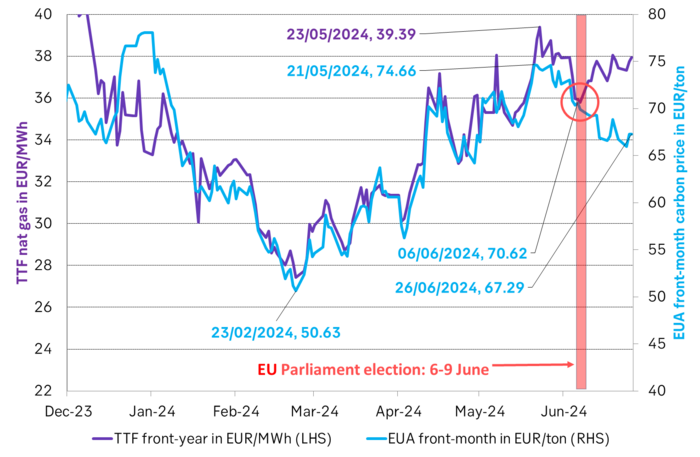
The EU Parliament election on 6-9 June was a big backlash for the Greens. The Greens experienced an euphoric victory in the 2019 election when they moved from 52 seats to 74 seats in the Parliament. Since then we have had an energy crisis with astronomic power and nat gas prices, rampant inflation and angry consumers being hurt by it all. In the recent election the Greens in the EU Parliament fell back to 53 seats. Close to where they were before 2019.
While green politics and CO2 prices may have gotten a lot of blame for the pain from energy prices over the latest 2-3 years, the explosion in nat gas prices are largely to blame. But German green policies to replace gas and oil heaters with heat pumps and new environmental regulations for EU farmers are also to blame for the recent pullback in green seats in the Parliament.
Green deal is still alive, but it may not be fully kicking any more. Existing Green laws may be hard to undo, but targets for 2035 and 2040 will be decided upon over the coming five years and will likely be weakened.
At heart the EU ETS system is a political system. As such the EUA price is a politically set price. It rests on the political consensus for environmental priorities on aggregate in EU.
The changes to the EU Parliament will likely weaken post-2030 environmental targets. The changes to the EU Parliament may not change the supply/demand balance for EUAs from now to 2030. But it will likely weaken post-2030 environmental targets and and thus projected EU ETS balances and EUA prices post-2030. And through the bankability mechanism this will necessarily impact EUA prices for the years from now to 2030.
Weaker post-2030 ambitions, targets and prices implies weaker EUA prices to 2030. EUA prices are ”bankable”. You can buy them today and hold on to them and sell them in 2030 or 2035. The value of an EUA today fundamentally rests on expected EUA prices for 2030/35. These again depends on EU green policies for the post 2030 period. Much of these policies will be ironed out and decided over the coming five years.
Weakening of post-2030 targets have yet to materialize. But just talking about it is a cold shower for EUAs. These likely coming weakenings in post-2030 environmental targets and how they will impact EUA prices post 2030 and thus EUA prices from now to 2030 are hard to quantify. But what is clear to say is that when politicians shift their priorities away from the environment and reduce their ambitions for environmental targets post-2030 it’s like a cold shower for EUA prices already today.
On top of this we now also have snap elections in the UK on 4 July and in France on 7 July with the latter having the potential to ”trigger the next euro crisis” according to Gideon Rachman in a recent article in FT.
What’s to be considered a fair outlook for EUA prices for the coming five years in this new political landscape with fundamentally changed political priorities remains to be settled. But that EUA price outlooks will be lowered versus previous forecasts is almost certain.
We reduce our EUA price forecast to 2030 by 10% to reflect the new political realities. To start with we reduce our EUA price outlook by 10% from 2025 to 2030 to reflect the weakened Green agenda in the EU parliament.
SEB’s EUA price forecast, BNEF price forecasts and current market prices in EUR/MWh
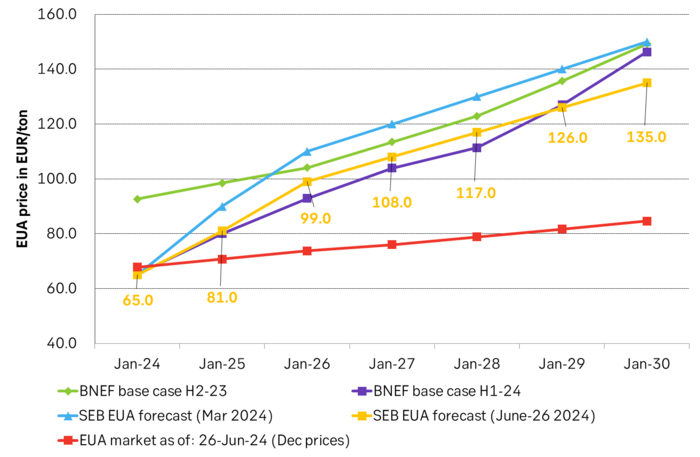
Analys
The most important data point in the global oil market will be published on Friday 28 June


US crude oil production has been booming for more than a decade. Interrupted by two setbacks in response to sharp price declines. The US boom has created large waves in the global oil market and made life very difficult for OPEC(+). Brent crude has not traded below USD 70/b since Dec-2021 and over the past year, it has averaged USD 84/b. US shale oil production would typically boom with such a price level historically. However, there has been zero growth in US crude oil production from Sep-2023 to Mar-2024. This may be partially due to a cold US winter, but something fundamentally seems to have changed. We recently visited a range of US E&P and oil services companies in Houston. The general view was that there would be zero growth in US crude oil production YoY to May 2025. If so and if it also is a general shift to sideways US crude oil production beyond that point, it will be a tremendous shift for the global oil market. It will massively improve the position of OPEC+. It will also sharply change our perception of the forever booming US shale oil supply. But ”the proof is in the pudding” and that is data. More specifically the US monthly, controlled oil production data is to be published on Friday 28 June.
The most important data point in the global oil market will be published on Friday 28 June. The US EIA will then publish its monthly revised and controlled oil production data for April. Following years of booming growth, the US crude oil production has now gone sideways from September 2023 to March 2024. Is this a temporary blip in the growth curve due to a hard and cold US winter or is it the early signs of a huge, fundamental shift where US crude oil production moves from a decade of booming growth to flat-lining horizontal production?
We recently visited a range of E&P and oil services companies in Houston. The general view there was that US crude oil production will be no higher in May 2025 than it is in May 2024. I.e. zero growth.
It may sound undramatic, but if it plays out it is a huge change for the global oil market. It will significantly strengthen the position of OPEC+ and its ability to steer the oil price to a suitable level of its choosing.
The data point on Friday will tell us more about whether the companies we met are correct in their assessment of non-growth in the coming 12 months or whether production growth will accelerate yet again following a slowdown during winter.
The US releases weekly estimates for its crude oil production but these are rough, temporary estimates. The market was fooled by these weekly numbers last year when the weekly numbers pointed to a steady production of around 12.2 m b/d from March to July while actual monthly data, with a substantial lag in publishing, showed that production was rising strongly.
The real data are the monthly, controlled data. These data will be the ”proof of the pudding” of whether US shale oil production now is about to shift from a decade of booming growth to instead flat-line sideways or whether it will drift gradually higher as projected by the US EIA in its latest Short-Term Energy Outlook.
US crude oil production given by weekly data and monthly data. Note that the monthly, controlled data comes with a significant lag. The market was thus navigating along the weekly data which showed ”sideways at 12.2 m b/d” for a significant period last year until actual data showed otherwise with a time-lag.
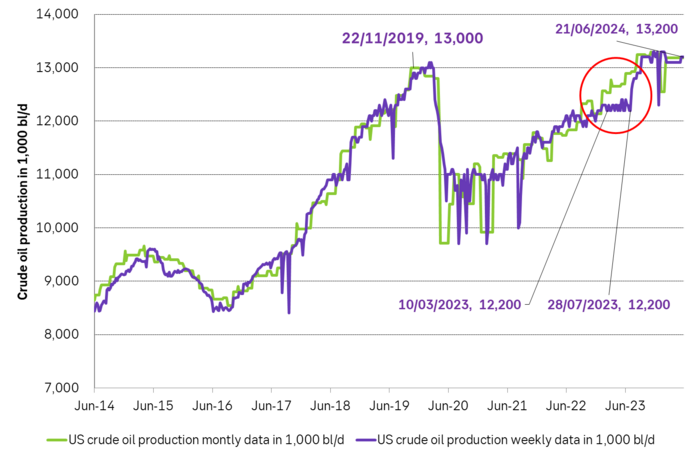
If we add in Natural Gas Liquids and zoom out to include history back to 2001 we see an almost uninterrupted boom in supply since Sep 2011 with a few setbacks. At first glance, this graph gives little support to a belief that US crude oil production now suddenly will go sideways. Simple extrapolation of the graph indicates growth, growth, growth.
US crude and liquids production has boomed since September 2011
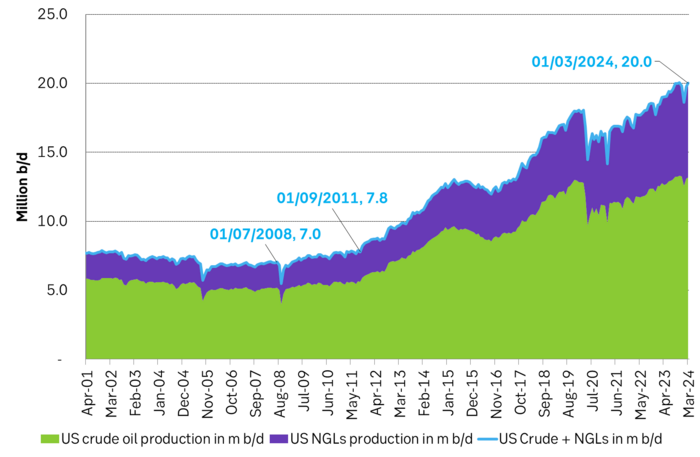
However. The latest actual data point for US crude oil production is for March with a reading of 13.18 m b/d. What stands out is that production then was still below the September level of 13.25 m b/d.
The world has gotten used to forever growing US crude oil production due to the US shale oil revolution, with shorter periods of sharp production declines as a result of sharp price declines.
But the Brent crude oil price hasn’t collapsed. Instead, it is trading solidly in the range of USD 70-80-90/b. The front-month Brent crude oil contract hasn’t closed below USD 70/b since December 2021.
Experiences from the last 15 years would imply wild production growth and activity in US shale oil production at current crude oil prices. But US crude oil production has now basically gone sideways to lower from September to March.
The big, big question is thus: Are we now witnessing the early innings of a big change in US shale oil production where we shift from booming growth to flat-lining of production?
If we zoom in we can see that US liquids production has flat-lined since September 2023. Is the flat-lining from Sep to Mar due to the cold winter so that we’ll see a revival into spring and summer or are we witnessing the early signs of a huge change in the global oil market where US crude oil production goes from booming growth to flat-line production.

The message from Houston was that there will be no growth in US crude oil production until May 2025. SEB recently visited oil and gas producers and services providers in Houston to take the pulse of the oil and gas business. Especially so the US shale oil and shale gas business. What we found was an unusually homogeneous view among the companies we met concerning both the state of the situation and the outlook. The sentiment was kind of peculiar. Everybody was making money and was kind of happy about that, but there was no enthusiasm as the growth and boom years were gone. The unanimous view was that US crude oil production would be no higher one year from now than it is today. I.e. flat-lining from here.
The arguments for flat-lining of US crude oil production here onward were many.
1) The shale oil business has ”grown up” and matured with a focus on profits rather than growth for the sake of growth.
2) Bankruptcies and M&As have consolidated the shale oil companies into larger, fewer public companies now accounting for up to 75% of total production. Investors in these companies have little interest/appetite for growth after having burned their fingers during a decade and a half of capital destruction. These investors may also be skeptical of the longevity of the US shale oil business. Better to fully utilize the current shale oil infrastructure steadily over the coming years and return profits to shareholders than to invest in yet more infrastructure capacity and growth.
3) The remaining 25% of shale oil producers which are in private hands have limited scope for growth as they lack pipeline capacity for bringing more crude oil from field to market. Associated nat gas production is also a problem/bottleneck as flaring is forbidden in many places and pipes to transport nat gas from field to market are limited.
4) The low-hanging fruits of volume productivity have been harvested. Drilling and fracking are now mostly running 24/7 and most new wells today are all ”long wells” of around 3 miles. So hard to shave off yet another day in terms of ”drilling yet faster” and the length of the wells has increasingly reached their natural optimal length.
5) The average ”rock quality” of wells drilled in the US in 2024 will be of slightly lower quality than in 2023 and 2025 will be slightly lower quality than 2024. That is not to say that the US, or more specifically the Permian basin, is quickly running out of shale oil resources. But this will be a slight headwind. There is also an increasing insight into the fact that US shale oil resources are indeed finite and that it is now time to harvest values over the coming 5-10 years. One company we met in Houston argued that US shale oil production would now move sideways for 6-7 years and then overall production decline would set in.
The US shale oil revolution can be divided into three main phases. Each phase is probably equally revolutionary as the other in terms of impact on the global oil market.
1) The boom phase. It started after 2008 but didn’t accelerate in force before the ”Arab Spring” erupted and drove the oil price to USD 110/b from 2011 to 2014. It was talked down time and time again, but it continued to boom and re-boom to the point that today it is almost impossible to envision that it won’t just continue to boom or at least grow forever.
2) The plateau phase. The low-hanging fruits of productivity growth have been harvested. The highest quality resources have been utilized. The halfway point of resources has been extracted. Consolidation, normalization, and maturity of the business has been reached. Production goes sideways.
3) The decline phase. Eventually, the resources will have been extracted to the point that production unavoidably starts to decline.
Moving from phase one to phase two may be almost as shocking for the oil market as the experience of phase 1. The discussions we had with oil producers and services companies in Houston may indicate that we may now be moving from phase one to phase two. That there will be zero shale oil production growth YoY in 2025 and that production then may go sideways for 6-7 years before phase three sets in.
US EIA June STEO report with EIA’s projection for US crude oil production to Dec-2025. Softer growth, but still growth.
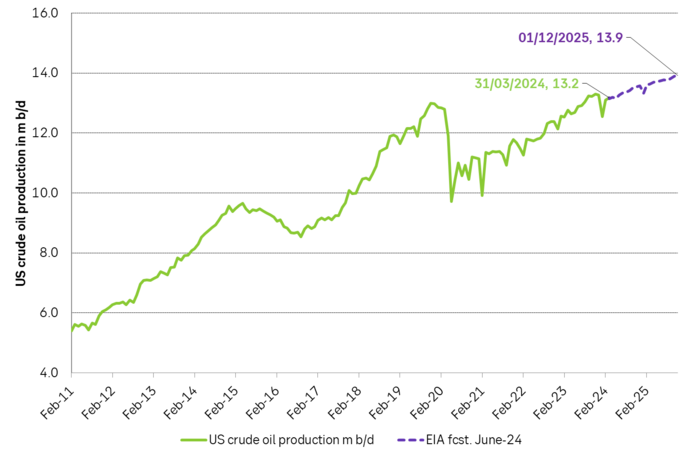
US EIA June STEO report with YoY outlook growth for 2025. Projects that US crude production will grow by 0.47 m b/d YoY in 2025 and that total liquids will grow by 720 k b/d YoY.
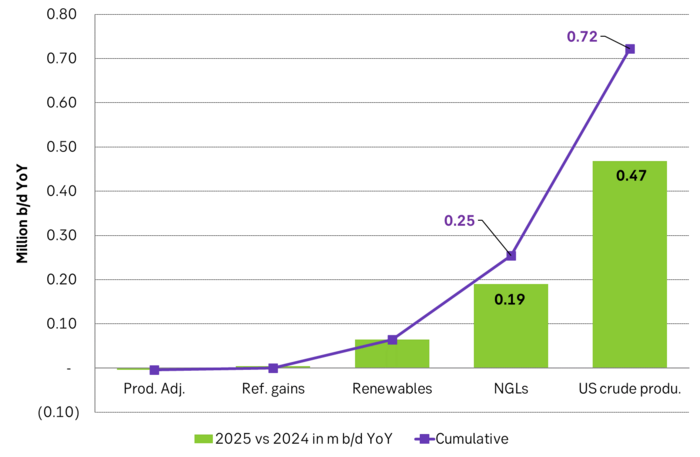
US EIA June STEO report with outlook for production growth by country in 2025. This shows how big the US production growth of 0.7 m b/d YoY really is compared to other producers around the world
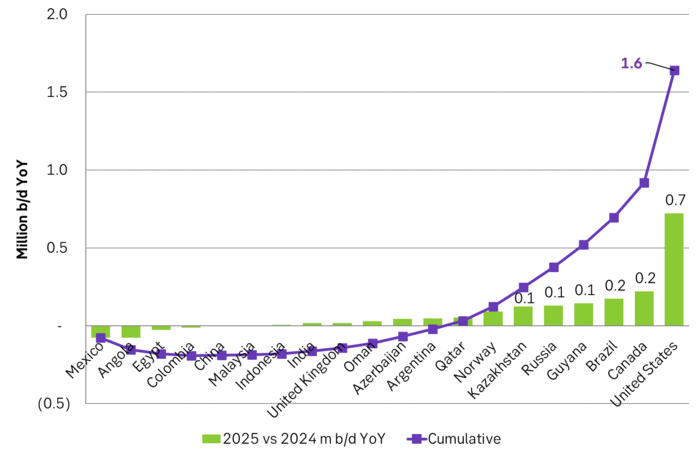
US EIA June STEO report with projected global growth in supply and demand YoY in 2025. Solid demand growth, but even strong supply growth with little room for OPEC+ to expand. Production growth by non-OPEC+ will basically cover global oil demand growth.
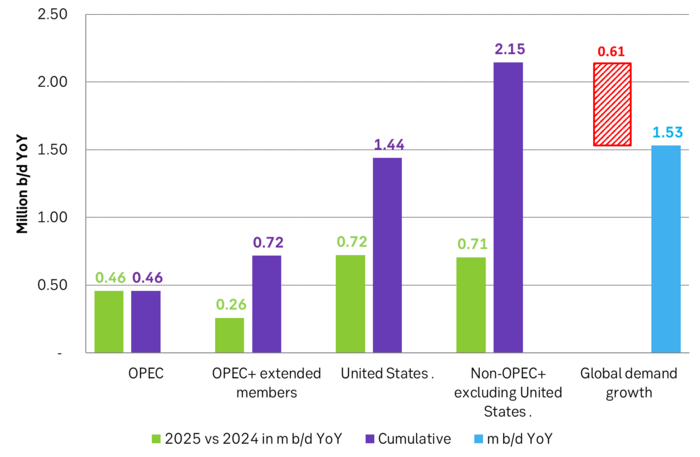
But if there instead is zero growth in US crude oil production in 2025 and the US liquids production only grows by 0.25 m b/d YoY due to NGLs and biofuels, then suddenly there is room for OPEC+ to put some of its current production cuts back into the market. Thus growth/no-growth in US shale oil production will be of huge importance for OPEC+ in 2025. If there is no growth in US shale oil then OPEC+ will have a much better position to control the oil price to where it wants it.
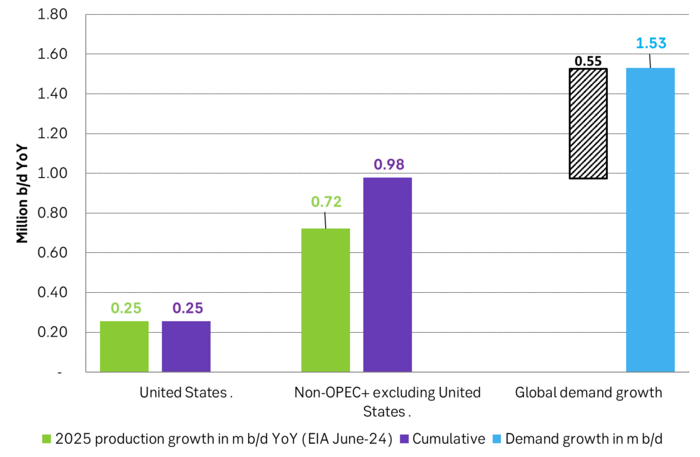
US crude oil production and drilling rig count
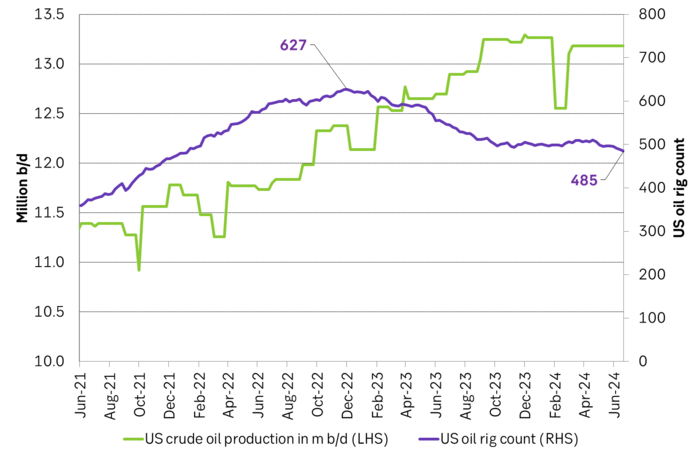
-

 Nyheter7 dagar sedan
Nyheter7 dagar sedanDe tre bästa råvaruvaruaktierna just nu
-

 Nyheter2 veckor sedan
Nyheter2 veckor sedanLundin Mining vill köpa Filo Corp tillsammans med BHP
-

 Nyheter4 veckor sedan
Nyheter4 veckor sedanAfrica Oil är bra att köpa anser Stifel som inleder analysbevakning
-
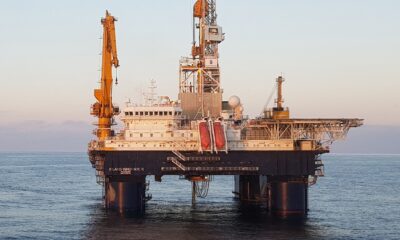
 Nyheter3 veckor sedan
Nyheter3 veckor sedanStor risk att Africa Energy inte överlever det kommande året
-
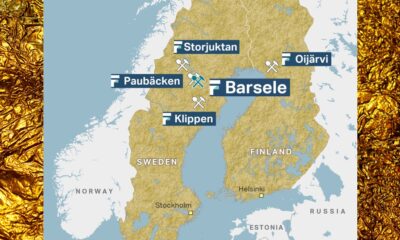
 Nyheter4 veckor sedan
Nyheter4 veckor sedanFirst Nordic Metals har fyra prospekteringsprojekt i Sverige
-

 Analys4 veckor sedan
Analys4 veckor sedanBrent crude inching higher on optimism that US inflationary pressures are fading
-

 Nyheter2 veckor sedan
Nyheter2 veckor sedanUniper satsar på att göra elektrobränsle av sin elektricitet
-

 Nyheter2 veckor sedan
Nyheter2 veckor sedanTre bra aktier inom olja och oljeservice i Kanada


